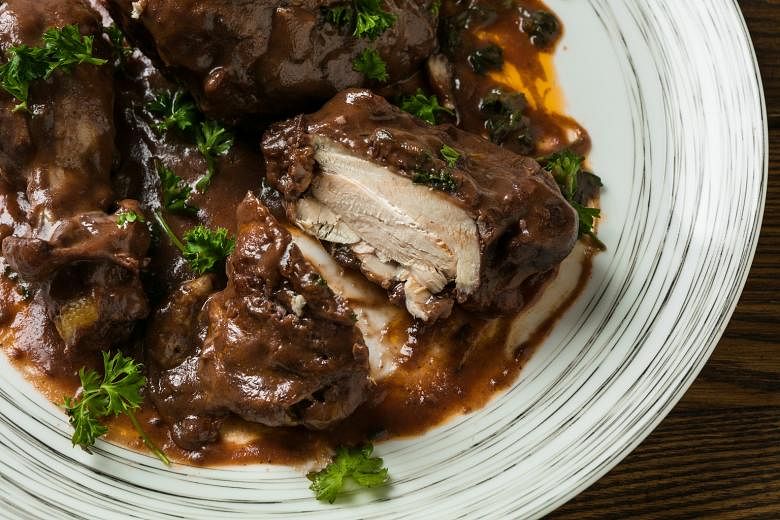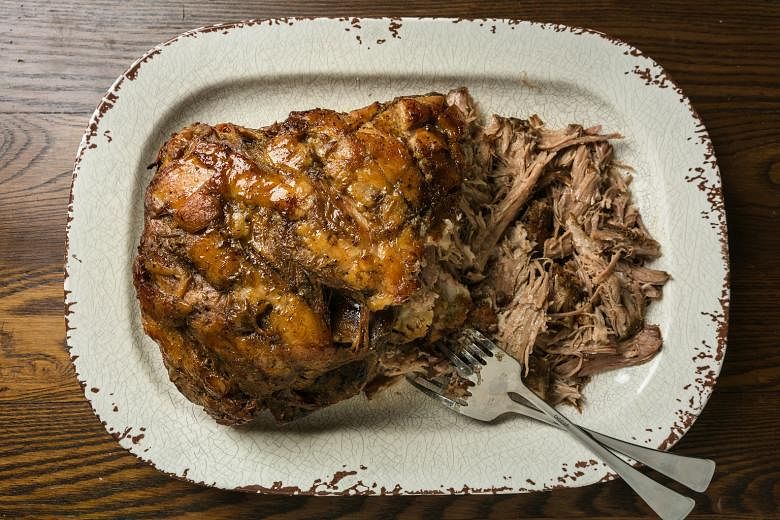(THE WASHINGTON POST) - "Oh, gosh. Oh, jeez."
Jude, my Instant Pot customer service representative, was flustered. I had called to ask - as anyone might - if it was okay to light cognac on fire in my Instant Pot. After a brief hold and a few nervous giggles, Jude gave me the go-ahead: No more than 15 to 20 seconds, ma'am, keep the lid off and remove the pot from its base. No problem, Jude.
Popular though Instant Pots are - Amazon sold enough during the holidays for 9 million bowls of chili - they provoke a lot of questions. One of mine (pyrotechnics aside) was: We know they're fast, but can they make my favourite dishes taste as good as traditional cooking?
I decided to put three recipes I love head to head, cooking them simultaneously in an Instant Pot and in a Dutch oven: coq au vin (chicken cooked in wine), pernil asado (Puerto Rican pork roast) and a black bean soup.
The Instant Pot is an electric multifunction pressure cooker, one of many on the market, and its charms include a searing setting. I've owned mine for a few months and have gone from scoffing newbie to evangelist.
"My black bean soup is the silkiest!" I might say, apropos of nothing, to a stranger at a party. "It was ready in 45 minutes! Using unsoaked dried beans!" The stranger would excuse herself to refill her glass, and somehow never wend her way back to me.
I love the ethos of cooking. I love a shimmering cast-iron skillet and uncovering my cherry-red Dutch oven to see a loaf of bread, as round and perfect as a fat baby. I love cooking's scents and sounds, and have groused that the Instant Pot - with its firm lock, 1980s-styled font and bleep-bloop buttons - eliminates some of that pleasure.
I can't tell when something's burning or if the beans are done, unless I shut everything off, release the pressure and unseal the machine, which takes a few minutes. Getting it back up to high-pressure temperature can take another half-hour.
Pressure cookers work, but to paraphrase George Michael, you gotta have faith.
For my test, I hewed as closely as possible to the traditional recipe, only adjusting when I thought it was necessary (such as volume of broth), doing research to make sure I was on track. As you get accustomed to using your electric pressure cooker, you'll get better at adapting your favourite recipes.
When I was in doubt about timing, I looked to Melissa Clark's excellent cookbook Dinner In An Instant.
My Staub 51/2-quart (5.2-litre) Dutch oven went head to head with the 6-quart Instant Pot DUO60. Since part of the appeal of each method is that you can do the steps easily in one pot, saving yourself a skillet to wash, I did so.
I also invited Allison Plumer, co-owner and chef de cuisine of Brooklyn restaurant Lot 2, to taste every dish blind with me. I'm a fan of Plumer's food - crisp carnitas, great burgers - and trust her palate.
Here are our verdicts.
Pernil Asado
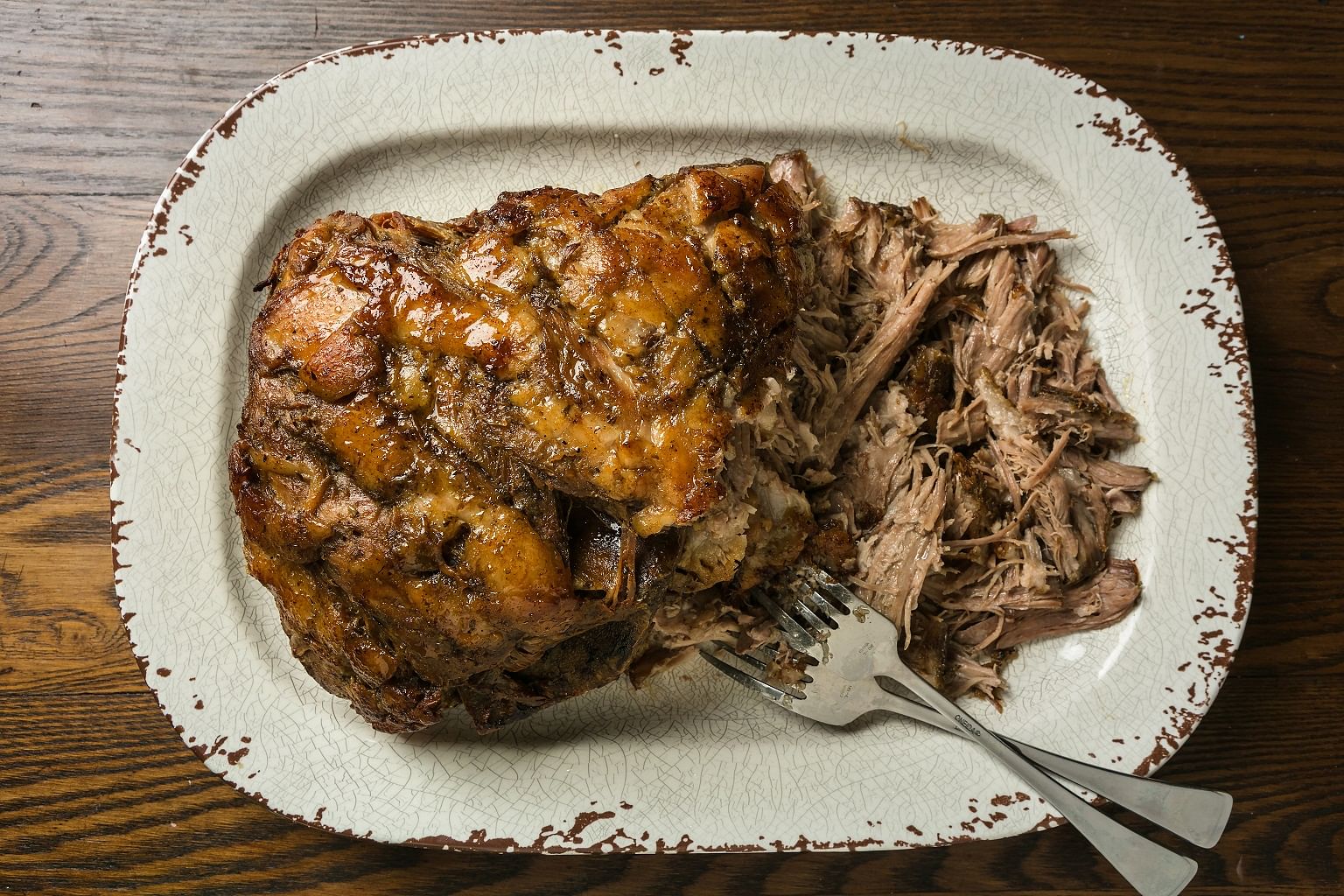
I've made this recipe a dozen times in my Dutch oven, and I love it: all garlic, fresh herbs and tons of bright citrus. Pernil is a classic Puerto Rican roast that takes hours to cook in the oven, but it results in falling-apart meat. I marinated both 1.8kg roasts for 16 hours. The traditional roast cooked for 4 1/2 hours, whereas the Instant Pot version - cut into four hunks, with the bone removed but thrown in - took half that time.
I flipped and basted the Dutch oven roast as I went along, and was pleased with the result: shellacked, dark-brown skin and tender meat. In the Instant Pot, however, everything melted into a meaty, fatty mess. I plucked out the meat using tongs, simmered the sauce for five minutes to try to condense the flavours, and was able to skim off a tablespoon or two of fat.
There were no crisp squares of skin to pluck off the top, while I cackled with glee, when it was done. I was disappointed: It was as though the shoulder had gone straight from marinade to leftovers, skipping the beautiful presentation part. But the meat was tender and very flavourful, so I pulled it apart and reintroduced it to the reduced marinade, letting it sit for a few minutes in its own fat.
Winner: Traditional. Plumer immediately identified the Dutch oven roast. "God, I really prefer that for textural purposes only," she said. "That is outstanding." She said that although the Instant Pot retained more of the distinct flavourings, this wasn't necessarily to its advantage: The traditional version had melded the flavours into one aromatic, juicy bite, and it worked better. However, the Instant Pot pork had confited as it sat in its fat, and that had helped improve the integration of fat and meat.
Coq au Vin
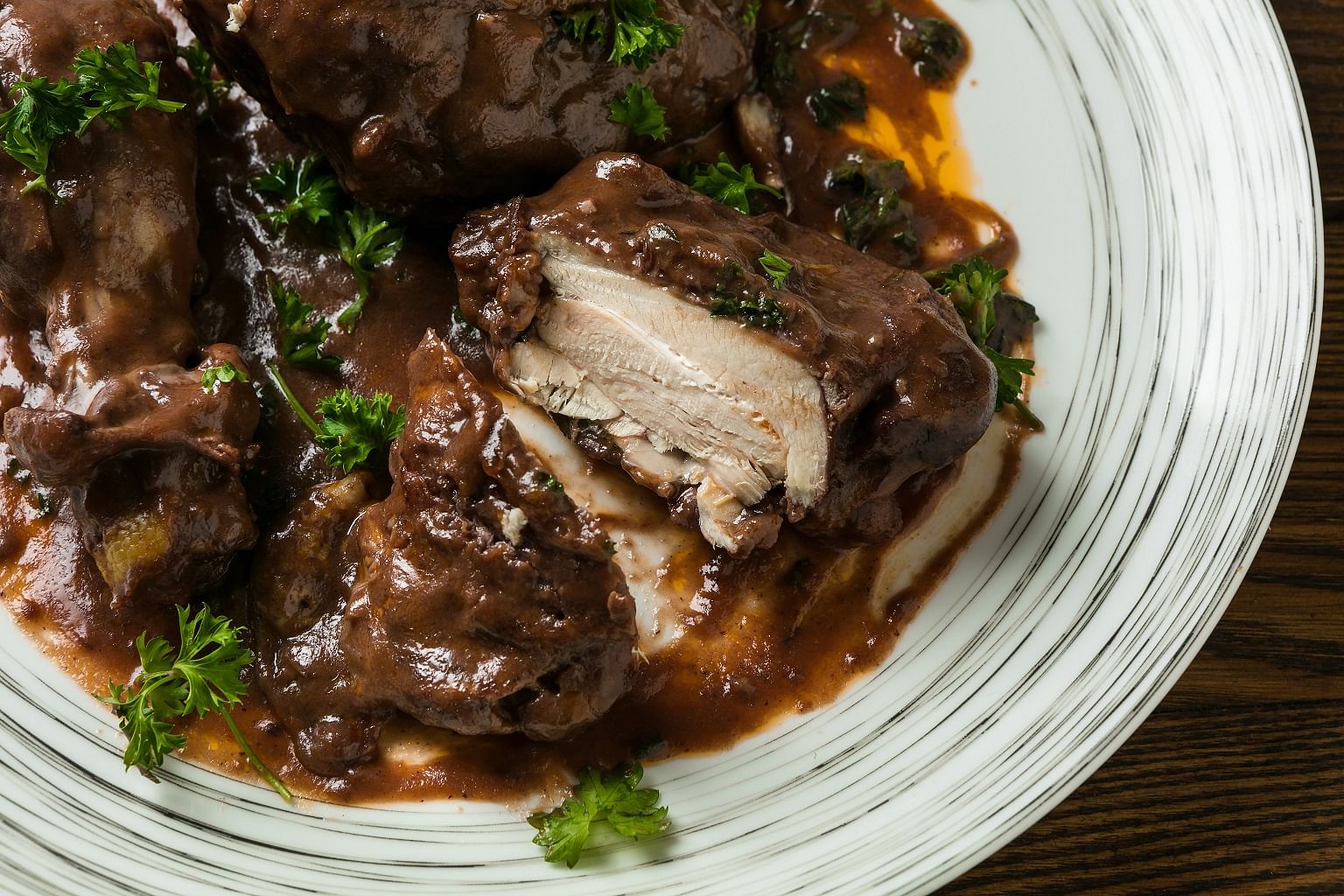
Surprisingly, both approaches required equal time: 2 hours and 5 minutes, which included breaking down the chickens and executing Julia Child's old-school techniques such as boiling, then blanching lardons: You could skip both steps and save time.
For the purposes of our test, I left out Child's traditional sides of mushrooms and onions, focusing on the chicken and its sauce.
Cooking the bird in the traditional pot takes a little longer, but the Instant Pot requires more time for searing (12 minutes) and bringing to pressure (12 minutes) before cooking (for 13), releasing steam (2 minutes), and simmering when the sauce is done (5 minutes).
Coq au vin gets its signature glossy sheen when you whisk in a butter-flour roux called beurre manie that gives it a silky texture. This disappeared easily in the stovetop sauce but not so well in the Instant Pot. Also, I was able to get a much crisper chicken skin searing the it in my Dutch oven.
As Clark wrote, "(The Instant Pot) doesn't do crisp or crunchy. So don't ask it to and you won't be disappointed."
Winner: Traditional. Julia would have been proud. The Staub sauce was "so delicious and perfectly emulsified," said Plumer, whereas the IP version was thin.
We noticed, too, that equal amounts of salt had not produced even results; the Instant Pot bird was under-salted. The pressure-cooked bird was "a satisfying chicken dish," Plumer said. "The at-home consumer would be super happy with this, if they'd never had coq au vin." But side-by-side with that luxe, properly seasoned traditional version? No contest.
Black Bean Soup
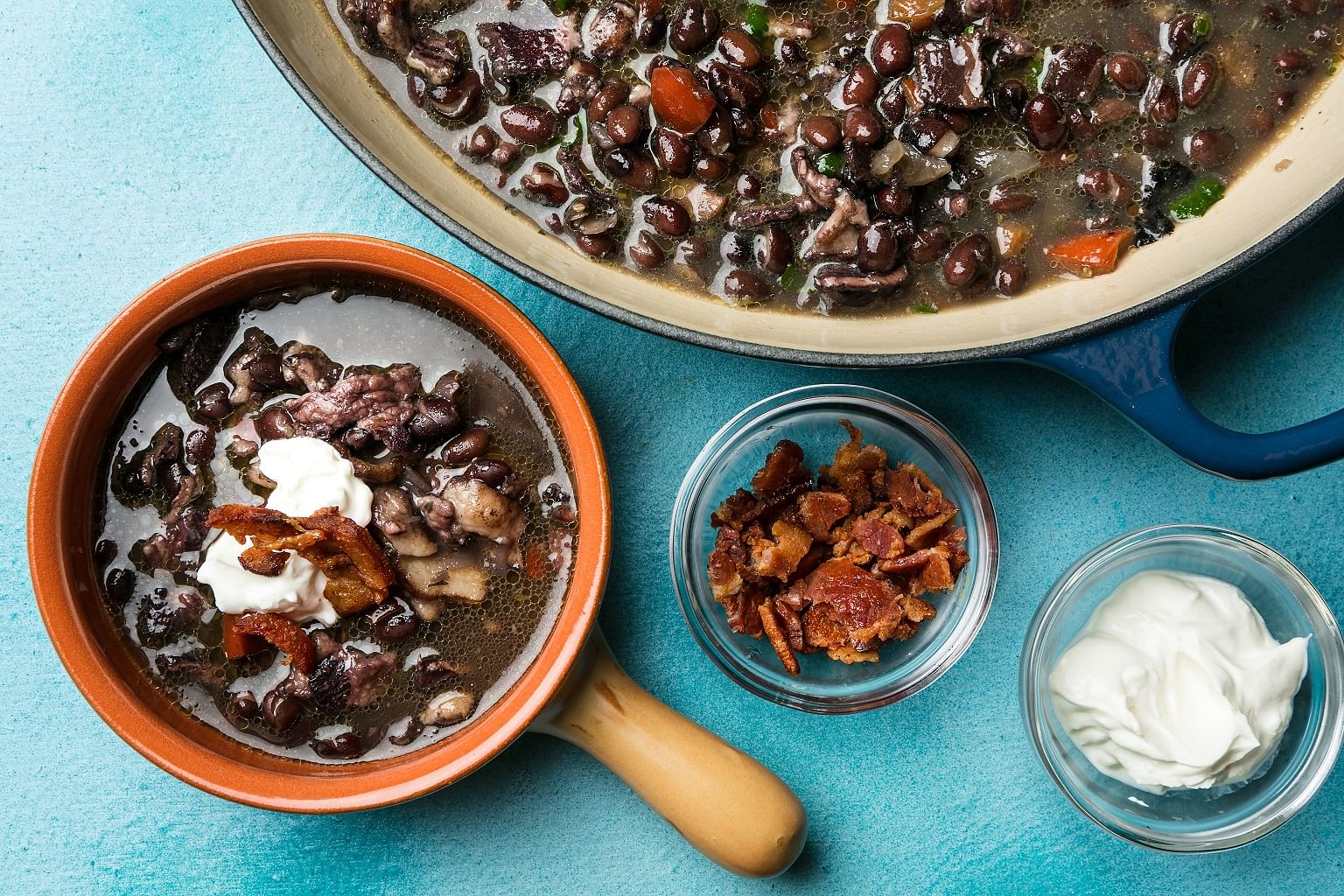
The Instant Pot shines when it comes to beans, since it eliminates traditional cooking and soaking times. For this test, the traditional approach took 17 hours (including rather a too-long soak; it could have "only" been 10 hours), whereas the Instant Pot required merely 2 1/2, all told.
Preheating the IP took 11 minutes, cooking took 50 - I like very soft, luxe beans, so I added 5 minutes of high pressure in two intervals - and the "natural release" of steam recommended in my research took a full 20 minutes.
I used only 5 cups of broth, for safety reasons, in the Instant Pot, as opposed to the three quarts required in the traditional.
Winner: Traditional. This time, the same recipe produced two wildly different dishes. The Dutch oven reduced the volume of the broth by three-quarters, and what a broth! With a booming, concentrated flavour, delicate aromatics and acid from the long-simmered red pepper, it was a delight. Interestingly, this was the one dish to trip up Plumer, who thought that - because she could taste the distinct flavours, as she did with pernil - the pressure cooker was responsible for the nuanced broth.
As for the Instant Pot soup, "everything in this bowl," Plumer said, frowning, "tastes like black beans." Whereas the traditional version had a broth with gorgeous flavours, this was more like a chili, black in hue and wanting sour cream, lime juice, salt and heat. Once I provided the garnishes it needed, it was very tasty (but lacked the transcendent broth of the other version).
One of my favourite recipes from Clark's book is her black bean chili, which has fresh tomato puree, cilantro and scallions swirled in just before serving. Keep this in mind if you're making a bean soup; add freshness, heat, acid and salt to taste at the end.
As a test to make sure broth volume wasn't the issue, I later pressure-cooked 141g of beans in 10 cups of liquid, and found that still, the taste of beans permeated all the broth.
The final assessment
Having tasted what the Instant Pot can and can't do, would Plumer recommend buying one?
She would, "but to a working professional who doesn't have two hours to devote to cooking dinner every night". She said that her restaurant, which generally offers the same menu, maintains a routine "because it's easy".
The same applies to the busy home cook. A pressure cooker allows you to make short ribs on a Wednesday night, she said, and how great is that? Plumer also allowed herself to get a little moony about what the machine could potentially do for beef stew, in which a uniform flavour and melting textures are the goal.
Its drawbacks? "It lacks the ability to finesse your dish."
So much about cooking is being able to monitor as something cooks, whether it's skimming fat off soup, basting a roast or salting beans as you go. The Instant Pot removes the option. "But if you're cooking for the family," added Plumer, "chances are your partner isn't going to be, like, 'Hey, you didn't salt all the way!'" And she admitted that she was impressed by the flavours of the pernil.
As the person who paid for an Instant Pot, I'm glad to have it. I'm cooking healthy proteins such as beans more often than I used to for hummus and minestrone and bean soups. I'll cook roasts and short ribs in it, and I've started throwing chicken thighs in it, then figuring out what to do with them when they're done 20 minutes later. It can be a huge timesaver, and it keeps the apartment cool. And some pressure cooker recipes are downright elegant, such as Clark's for salmon with Vietnamese caramel.
Could I live without a pressure cooker? Probably, but I'd miss it. The busy Instant Pot superfans I know - having become accustomed to their "set it and forget it" lifestyles - would go bananas without one. I'm not a parent, and I'm simply not as pressed for time as they are.
But then there's this, running parallel to the lure of speed: A cook's joy.
Though we ranked that pernil a hair below the traditional version, I won't cook it that way again (though I could have crisped up the fatty bits under my broiler). I would have missed out on the moment I love most: pulling the finished, glorious mess out of the oven, standing there alone, and picking off one square of crisp skin, eating it blissfully.
The cook's treat matters. It's the chocolate cookie warm out of the oven, dunked in cold milk, before you serve the rest to the people you love. Or the glass of wine - there's only one left when you're making coq au vin, after all - you drink, alone and happy, as everything starts to sizzle.
A gadget, I'd argue, can't give you that.
Pernil Asado
8 servings
Here, a garlicky citrus marinade turns a plain pork shoulder into a Puerto Rican classic. The dish gets its name because it was originally made with a fresh ham (from the pig's hind quarter).
Start making the pernil a day before you want to serve it, as it needs 12 to 24 hours to marinate. Pork shoulders may come larger than 1.8kg, which is what's called for in this recipe. Ask your butcher to cut it down, which can be tricky because this is a bone-in cut of meat.
To make this in an Instant Pot, see the variation, below.
Serve with rice and beans, or shred for tacos.
Adapted from recipes at Chowhound.com and Sofrito restaurant in New York.
INGREDIENTS
For the marinade
1/2 cup coarsely chopped garlic (from about 1 medium head)
Leaves from 8 to 10 stems fresh cilantro
1/4 cup fresh lemon juice (from 2 lemons)
1/4 cup fresh sour orange juice (from about 2 medium; may substitute a 50-50 blend of fresh lemon juice and fresh grapefruit juice)
1/4 cup packed fresh oregano leaves
1/4 cup water, or more as needed
3/4 cup extra-virgin olive oil
3/4 cup vegetable oil
For the pork
3 Tbs kosher salt
1 Tbs dried oregano
2 tsps freshly ground black pepper
One 1.8kg, bone-in pork shoulder (butt; see headnote)
METHOD
1. For the marinade: Combine the garlic, cilantro, citrus juices, oregano and water in a blender; puree to form a smooth, thick liquid. With the motor running, add the oils in a slow, steady stream until evenly incorporated. Transfer to a gallon-size zip-top plastic bag.
2. For the pork: Combine the salt, oregano and pepper in a small bowl.
3. Rinse the pork with cold water and pat dry with paper towels. Use a sharp knife to cut the skin and/or fat cap on your pork shoulder in a crosshatch pattern, leaving about 2.5cms of space between the cuts. Be sure to slice through the layer of fat below the skin, but not into the meat itself.
4. Rub the pork all over with the salt mixture, then the marinade, pushing the marinade into the nooks and crannies. Place in the marinade bag; seal and refrigerate, turning occasionally, for 12 to 24 hours.
5. Let the pork sit at room temperature for 30 to 45 minutes while you preheat the oven to176 degrees Celsius. Reserve the marinade.
6. Place the pork shoulder fat-cap side up in a Dutch oven or other large, heavy-bottomed pot with a tight-fitting lid. Add 3/4 cup of the marinade and the water. Cover and roast (middle rack) for 3 to 5 hours, until the meat is fork-tender. Use tongs or large forks to flip the roast every hour or so, and use some of the marinade mixture to baste the meat. Add a tablespoon of water or two if the pan is dry. Finish cooking for last hour with fat-cap side up.
7. To help crisp the fat cap on top of the pork and further brown the meat, uncover the pot and increase the oven temperature to 190 degrees. Roast for 10 to 15 minutes.
8. Place the meat in a large bowl or on a large cutting board with a channel that can catch the juices. Use two forks to shred the roast pork into bite-size pieces. Add 1/2 cup of the pan juices (or as much as you like), and stir to incorporate.
VARIATION: To make the pernil in an Instant Pot, ask the butcher to remove the bone from pork shoulder and cut the meat into four equal pieces; reserve the bone.
Follow the marinating directions above. Remove the shoulder from the marinade and shake dry; reserve the marinade.
Add 1 1/2 tablespoons extra-virgin olive oil to the Instant Pot. Set to SAUTE on high heat; add the hunks of meat and sear them on all sides, about 3 minutes per piece, in batches, then transfer them to a plate.
Add the reserved marinade to the Instant Pot. Use a wooden spoon to scrape away any blackened bits. Turn off the heat. Arrange the hunks of pork around in the pot, then baste with the reserved marinade. Add the bone, cover and cook at high pressure for 80 minutes.
Let the pressure release naturally. Transfer the meat to a cutting board.
Cook the marinade over medium heat until slightly reduced; skim fat and season, as needed. Add the pork and shred it with forks. Crisp the pork under the broiler, if desired.
Ingredients are too variable for a meaningful analysis.
Coq au Vin (Chicken in Red Wine)
4 to 6 servings
This dish is typically served with pearl onions or sauteed mushrooms, but its sauce is so luxe that it goes great with mashed or roasted potatoes, polenta or simply fresh bread, too.
You're doing a quick flame of alcohol in both traditional and Instant Pot methods, and should be appropriately careful (follow the directions closely and carefully).
To make this in an Instant Pot, see the variation, below.
You'll need a heavy,25cm Dutch oven.
The chicken tastes even better after a day's refrigeration.
Adapted from the 50th anniversary edition of Mastering The Art Of French Cooking by Julia Child, Louisette Bertholle and Simone Beck (Alfred A. Knopf, 2011).
INGREDIENTS
One 85 to 113g chunk of lean bacon, rind discarded
4 Tbs salted or unsalted butter
1.1 - 1.3kgwhite- and dark-meat chicken parts (bone-in, skin-on)
1/2 tsp kosher salt
1/8 tsp freshly ground black pepper
1/4 cup Cognac
3 cups young, full-bodied red wine such as Burgundy, Beaujolais, Côtes du Rhône or Chianti
1 to 2 cups brown chicken stock or broth, brown stock or beef bouillon
1 1/2 tsps tomato paste
2 cloves garlic, mashed
1/4 tsp dried thyme
1 bay leaf
Kosher salt
Freshly ground black pepper
3 Tbs flour
Sprigs of fresh parsley, for garnish
METHOD
1. Cut the bacon into lardons (rectangles 0.5cm across and 2.5cms long). Cook for 10 minutes in 2 quarts of water. Rinse in cold water. Dry.
2. Melt 2 tablespoons of the butter in the pot, over medium-low heat. Add the bacon pieces and cook for about 3 minutes, until very lightly browned. Use a slotted spoon to transfer them to a plate.
3. Dry the chicken thoroughly with paper towels. Place the pieces in the pot; brown them in the hot bacon fat, turning them over, as needed. Season the chicken lightly with the salt and pepper. Return the bacon to the pot. Cover and cook for 10 minutes, turning the chicken pieces over once.
4. Uncover, and pour in the Cognac. Carefully ignite the liquor with a lighted match or torch. Shake the pot back and forth for several seconds until the flames subside.
5. Pour the wine into the pot. Add just enough stock or broth or bouillon to cover the chicken. Stir in the tomato paste, garlic and herbs. Once the liquid begins to bubble at the edges, cover and cook slowly for 25 to 30 minutes, or until the chicken is tender and its juices run a clear yellow when the meat is pricked with a fork. Transfer the chicken pieces to a platter.
6. Cook the liquid in the pot for a minute or two, skimming off any fat. Increase the heat to high and boil rapidly, reducing the liquid to about 2 1/4 cups. Taste, and adjust the seasoning, as needed. Remove from the heat, and discard the bay leaf.
7. Blend the remaining 2 tablespoons of butter with flour in a bowl to create a smooth paste (called a beurre manie). Whisk the paste into the hot liquid. Once the liquid bubbles at the edges, cook, stirring, for a few minutes, to form a sauce that's thick enough to coat a spoon lightly.
8. Arrange the chicken in a casserole dish and baste it with the sauce. Garnish with sprigs of parsley.
9. If the dish is not to be served right away, pour a layer of broth on the surface or dot the surface with small pieces of butter. Shortly before serving, heat over medium heat so the liquid in the pot bubbles at the edges while you baste the chicken with its sauce. Reduce the heat to medium-low, cover and cook for 4 to 5 minutes, until the chicken is hot through.
VARIATION: To make this Coq au Vin in an Instant Pot, start the bacon as directed above (by boiling the lardons in water). Then cook those bacon pieces in butter, uncovered, with the SAUTE button on medium.
Add the chicken pieces in batches - don't crowd them - with the SAUTE button on high. Turn off the machine before you light the Cognac in the Instant Pot. Keep the lid off and transfer the metal base to the kitchen sink or other safe space away from plastic or meltable materials.
To finish the chicken, follow the directions above, but cook at high pressure for 12 minutes, releasing the pressure manually. Transfer the chicken pieces to a platter. Set the SAUTE button to medium and cook the sauce in pot (as directed above).
Nutrition | Per serving: 580 calories, 30 g protein, 7 g carbohydrates, 35 g fat, 13 g saturated fat, 140 mg cholesterol, 430 mg sodium, 0 g dietary fiber, 1 g sugar
Black Bean Soup
4 to 6 servings
Bacon, red bell pepper and jalapeño deepen the flavour of this earthy soup. The stove-top version makes a nuanced broth, while the Instant Pot version yields a somewhat starchier-tasting broth. See the variation, below. Both are tasty; we noticed in testing that the yield was greater for the Instant Pot soup.
Adapted from recipes at Epicurious.com and from the Enchantment Resort in Sedona, Arizona.
INGREDIENTS
283g dried black beans, picked over and rinsed
8 slices bacon (198g total), chopped
1 small onion, cut into 0.5cm dice
1/2 red bell pepper, seeded and cut into 0.5cm dice
1 1/2 tsp chopped garlic
1/2 tsp finely chopped seeded jalapeno pepper
1 1/2 tsp dried oregano, crumbled
1 Turkish or 1/2 California bay leaf
1/2 tsp dried thyme, crumbled
12 cups low-sodium chicken broth
3/4 tsp freshly ground white pepper
2 Tbs chopped fresh cilantro, plus more for optional garnish
Sour cream, for garnish
METHOD
1. Cover the beans with cold water by 7cms in a bowl and soak at room temperature at least 8 hours, or quick-soak (see the note, below). Drain thoroughly.
2. Place the chopped bacon in a 5- to 6-quart heavy pot over medium heat; cook for 6 to 12 minutes, stirring occasionally, until golden. Use a slotted spoon to transfer the pieces to a bowl. Pour off all but 1 tablespoon fat from pot. Reserve 2 tablespoons of the chopped bacon for garnish, then return remaining bacon to pot, over medium heat. Once it and the bacon fat is quite hot, add the onion, bell pepper, garlic, jalapeño, oregano, bay leaf and thyme; cook for 5 or 6 minutes, stirring frequently, until onion is softened.
3. Add the beans, broth and white pepper; partially cover and cook for about 2 1/2 hours, stirring occasionally, until beans are quite tender. Discard the bay leaf and stir in 2 tablespoons of chopped cilantro.
4. Serve warm, topped with sour cream, more chopped cilantro, if using, and the reserved bacon.
VARIATION: To make this soup in an Instant Pot, combine the bacon, onion, bell pepper, herbs and jalapeno in it. Use the SAUTE button and set to high. Use 5 cups of broth (instead of the 12 cups listed above). Don't soak beans overnight: Just rinse, add to other ingredients, and cook on high pressure for 40 minutes. Let the pressure release naturally, which can take about 15 minutes. If you prefer softer beans, add 5 or 6 minutes of high pressure and release manually.
NOTE: To soak the beans faster, first rinse them and pick them over to remove any debris. Place the beans in a saucepan and cover with water by about 5 inches. Bring to a boil over high heat; cook for 1 minute, then remove from the heat. Cover and let sit for 1 hour, then drain and rinse.
Nutrition | Per serving (based on 6): 310 calories, 24 g protein, 39 g carbohydrates, 9 g fat, 3 g saturated fat, 10 mg cholesterol, 320 mg sodium, 12 g dietary fiber, 9 g sugar

